DSM-Firmenich Bundle
Who Really Owns DSM-Firmenich?
Unraveling the intricacies of corporate ownership is crucial for any investor or strategist. The merger of Royal DSM and Firmenich created a global powerhouse, dsm-firmenich, but who ultimately controls this titan in the nutrition, health, and beauty sectors? Understanding the DSM-Firmenich SWOT Analysis is just the beginning.
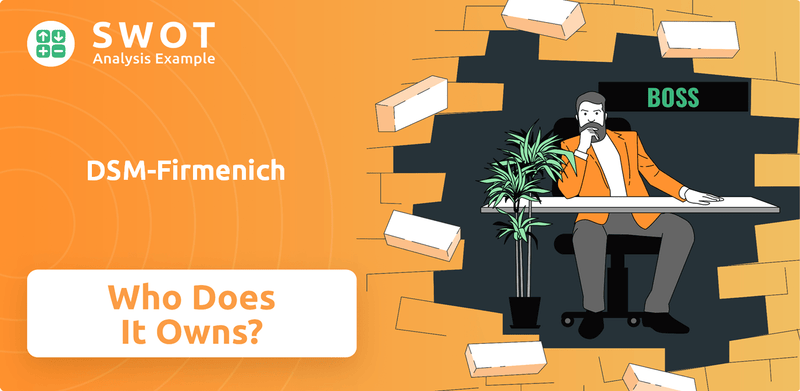
This exploration into DSM-Firmenich ownership will illuminate the company's structure, from its roots in Dutch State Mines and the family-owned Firmenich to its current status. We'll examine the major shareholders, the influence of investors, and the overall ownership dynamics. Discover the answers to questions like "Who owns DSM-Firmenich?" and "Is DSM-Firmenich a publicly traded company?" to gain a comprehensive understanding of this industry leader.
Who Founded DSM-Firmenich?
The current entity, dsm-firmenich, emerged from a 'merger of equals' between Royal DSM and Firmenich. Understanding the DSM-Firmenich ownership structure requires examining the historical backgrounds of these two distinct companies.
Royal DSM, founded in 1902, began as a state-owned coal mining company in the Netherlands. Over time, it transitioned and was fully privatized by 1996, with shares listed on the Amsterdam Stock Exchange. Firmenich SA, established in 1895 in Geneva, Switzerland, had a different origin.
Firmenich SA was founded by chemist Philippe Chuit and businessman Martin Naef, originally named Chuit & Naef. Fred Firmenich joined in 1900 and later became the majority partner, leading to the renaming of the company to Firmenich SA. Firmenich remained a privately-owned, family-controlled company for 127 years until its merger with DSM.
Initially, Royal DSM was owned by the Dutch government. This reflects a different starting point compared to Firmenich.
Firmenich was founded by Philippe Chuit and Martin Naef. Fred Firmenich later became the majority partner.
Royal DSM was fully privatized by 1996. Shares were floated on the Amsterdam Stock Exchange.
Firmenich remained a privately-owned, family-controlled company for over a century before the merger.
The merger between DSM and Firmenich created the current dsm-firmenich entity. The specific equity split at the inception of Firmenich is not publicly detailed.
Understanding the DSM-Firmenich company ownership structure requires looking at the history of both companies.
The historical context reveals that Royal DSM transitioned from government to public ownership, while Firmenich maintained family control for many years. The merger brought together these two entities, creating the current DSM-Firmenich shareholders structure. For more detailed information, you can read this article about the company: 0. The specific details of the initial equity split between Philippe Chuit and Martin Naef at Firmenich's inception are not publicly available. The company's long history as a family-owned entity highlights the significant control and vision of the Firmenich family from the beginning.
The evolution of DSM-Firmenich ownership reflects a merger of two companies with different ownership histories.
- Royal DSM began as a state-owned entity and later became publicly traded.
- Firmenich was a privately-owned, family-controlled company for over a century.
- The merger of these two companies created the current dsm-firmenich.
- Understanding the initial ownership structures of Royal DSM and Firmenich provides insights into the current DSM-Firmenich investors landscape.
DSM-Firmenich SWOT Analysis
- Complete SWOT Breakdown
- Fully Customizable
- Editable in Excel & Word
- Professional Formatting
- Investor-Ready Format
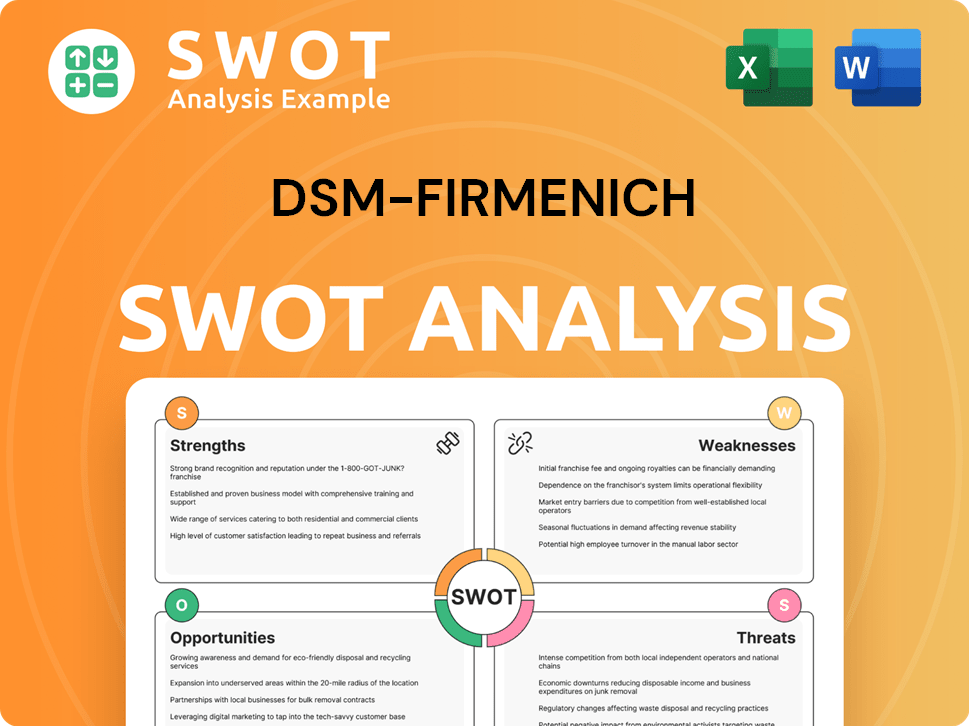
How Has DSM-Firmenich’s Ownership Changed Over Time?
The merger in May 2023 dramatically reshaped the DSM-Firmenich ownership landscape. Initially, former DSM shareholders held 65.5% of the combined entity, while Firmenich shareholders, including the Firmenich family, owned the remaining 34.5% and received €3.5 billion in cash. This marked the creation of a publicly listed company on Euronext Amsterdam, merging two companies with separate ownership structures.
The DSM-Firmenich company ownership structure has evolved since the merger. Institutional investors now hold a significant stake, approximately 37% as of November 2024. The top 25 shareholders control 46% of the company, indicating a relatively dispersed ownership. Insiders, including the Firmenich family, retain a 26% ownership. Norges Bank Investment Management stands out as the largest institutional shareholder, holding 4.9% of the outstanding shares. The Firmenich family's continued involvement is reinforced through relationship agreements with the company.
| Ownership Category | Percentage of Shares | Approximate Ownership |
|---|---|---|
| Institutional Investors | 37% | Significant |
| Top 25 Shareholders | 46% | Concentrated |
| Insiders (including Firmenich family) | 26% | Substantial |
As of December 31, 2024, the company's share capital was €2,656,763.88, divided into 265,676,388 fully paid-up registered shares, each with a par value of €0.01. The company also has conditional capital for employee benefit plans and equity-linked financing instruments. For more insights into the company's strategic direction, consider reading about the Growth Strategy of DSM-Firmenich.
The merger in 2023 was a pivotal event, reshaping the ownership structure.
- Institutional investors hold a substantial portion of the shares.
- The Firmenich family remains a key stakeholder.
- The company is publicly listed on Euronext Amsterdam.
- The share capital structure is clearly defined.
DSM-Firmenich PESTLE Analysis
- Covers All 6 PESTLE Categories
- No Research Needed – Save Hours of Work
- Built by Experts, Trusted by Consultants
- Instant Download, Ready to Use
- 100% Editable, Fully Customizable
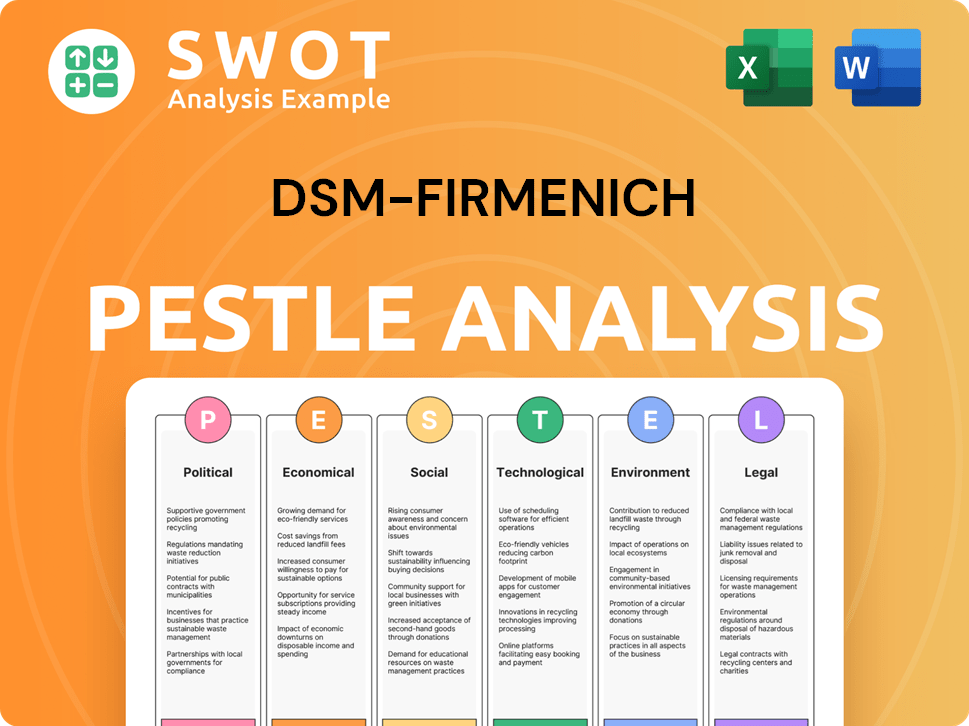
Who Sits on DSM-Firmenich’s Board?
As of December 31, 2024, the Board of Directors for dsm-firmenich comprised 11 non-executive members. The Chairman of the Board is Thomas Leysen, re-elected in May 2025. Patrick Firmenich serves as Vice Chairman, representing the Firmenich family, a major shareholder. Other board members re-elected in May 2025 include Sze Cotte-Tan, Antoine Firmenich, Erica Mann, Carla Mahieu, Frits van Paasschen, André Pometta, John Ramsay, Richard Ridinger, and Corien Wortmann.
The Firmenich family's significant shareholding grants them specific nomination rights. Any Firmenich Shareholder, holding 17% or more of the company's issued share capital, can nominate two Board members, with a maximum of three nominated directors in total. As of December 31, 2024, Patrick Firmenich and Antoine Firmenich are the Nominated Directors, who are not considered independent. Understanding the DSM-Firmenich ownership structure is key for DSM-Firmenich investors and stakeholders.
| Board Member | Position | Nominated by |
|---|---|---|
| Thomas Leysen | Chairman | N/A |
| Patrick Firmenich | Vice Chairman | Firmenich Family |
| Antoine Firmenich | Board Member | Firmenich Family |
| Sze Cotte-Tan | Board Member | N/A |
| Erica Mann | Board Member | N/A |
| Carla Mahieu | Board Member | N/A |
| Frits van Paasschen | Board Member | N/A |
| André Pometta | Board Member | N/A |
| John Ramsay | Board Member | N/A |
| Richard Ridinger | Board Member | N/A |
| Corien Wortmann | Board Member | N/A |
The voting structure generally operates on a one-share-one-vote basis. At the May 6, 2025, Annual General Meeting (AGM), shareholders approved all Board proposals. The 2024 consolidated financial statements and the Sustainability Report were approved with 72.72% of shares represented. Shareholders also approved the remuneration for the Board of Directors (€3,682,582 for the year through the 2026 AGM) and the Executive Committee (€43,982,072 for financial year 2026). This demonstrates the influence of DSM-Firmenich shareholders in governance. For more insights, you can explore the Competitors Landscape of DSM-Firmenich.
The Board of Directors consists of 11 non-executive members, with the Firmenich family holding nomination rights.
- Thomas Leysen is the Chairman, and Patrick Firmenich is the Vice Chairman.
- The Firmenich family can nominate up to three directors.
- Shareholders approved key proposals at the AGM, including financial statements and remuneration.
DSM-Firmenich Business Model Canvas
- Complete 9-Block Business Model Canvas
- Effortlessly Communicate Your Business Strategy
- Investor-Ready BMC Format
- 100% Editable and Customizable
- Clear and Structured Layout
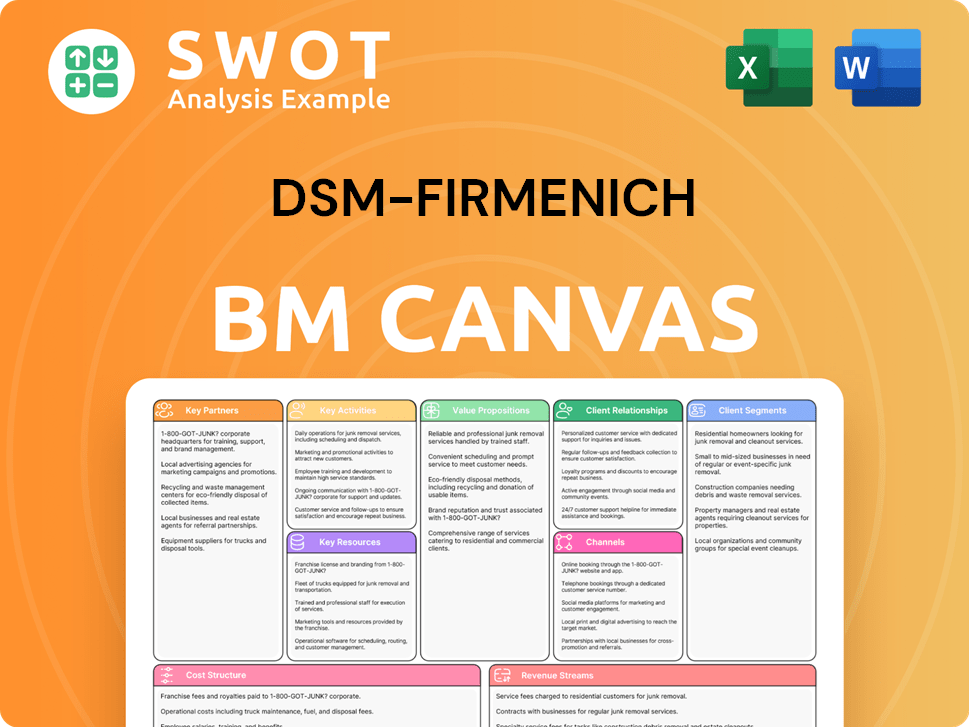
What Recent Changes Have Shaped DSM-Firmenich’s Ownership Landscape?
Over the past couple of years, the ownership structure of dsm-firmenich, a leading company in nutrition, health, and beauty, has seen significant strategic shifts. In February 2024, the company announced plans to separate its Animal Nutrition & Health (ANH) business, aiming to unlock its full potential under a different ownership model. This separation is slated for completion throughout 2025. Furthermore, as part of its portfolio adjustments, dsm-firmenich divested its stake in the Feed Enzymes Alliance to Novonesis for €1.5 billion in February 2025. This transaction involved approximately €300 million in annual net sales in 2024. In December 2024, the company also sold its shares in Robertet, a French flavor, fragrance, and ingredient company, for nearly €400 million, thus exiting its ordinary shares in the company.
In addition to portfolio adjustments, dsm-firmenich has launched a share buyback program. In February 2025, the company declared its intention to repurchase ordinary shares with an aggregate market value of €1 billion. The initial phase of €500 million is scheduled to begin in Q2 2025, with the complete program expected to conclude by Q2 2026. This initiative is designed to reduce the issued capital. In April 2024, dsm-firmenich repurchased 500,000 ordinary shares for €51.6 million to cover share-based compensation plans and anticipated the acquisition of an additional 1,000,000 shares through an equity forward transaction in 2025. These actions highlight the company's active management of its capital structure, impacting the DSM-Firmenich ownership landscape.
Industry trends suggest an increase in institutional ownership as companies mature. While specific founder dilution percentages for dsm-firmenich after the merger aren't detailed beyond the initial ownership split, the substantial institutional holdings and ongoing share buyback programs align with a publicly traded company's capital management practices. The company's strategic focus for 2025 centers on expanding its core consumer-oriented businesses, specifically in Perfumery & Beauty, Taste, Texture & Health, and Health, Nutrition & Care. For more insights into the company's strategic direction, consider exploring the Marketing Strategy of DSM-Firmenich. The company is prioritizing organic growth and operational efficiency.
Separation of Animal Nutrition & Health (ANH) business is planned for 2025.
Sale of Feed Enzymes Alliance for €1.5 billion and Robertet stake for almost €400 million.
€1 billion share repurchase program announced, with €500 million starting in Q2 2025.
Emphasis on growing core consumer-oriented businesses in 2025.
DSM-Firmenich Porter's Five Forces Analysis
- Covers All 5 Competitive Forces in Detail
- Structured for Consultants, Students, and Founders
- 100% Editable in Microsoft Word & Excel
- Instant Digital Download – Use Immediately
- Compatible with Mac & PC – Fully Unlocked
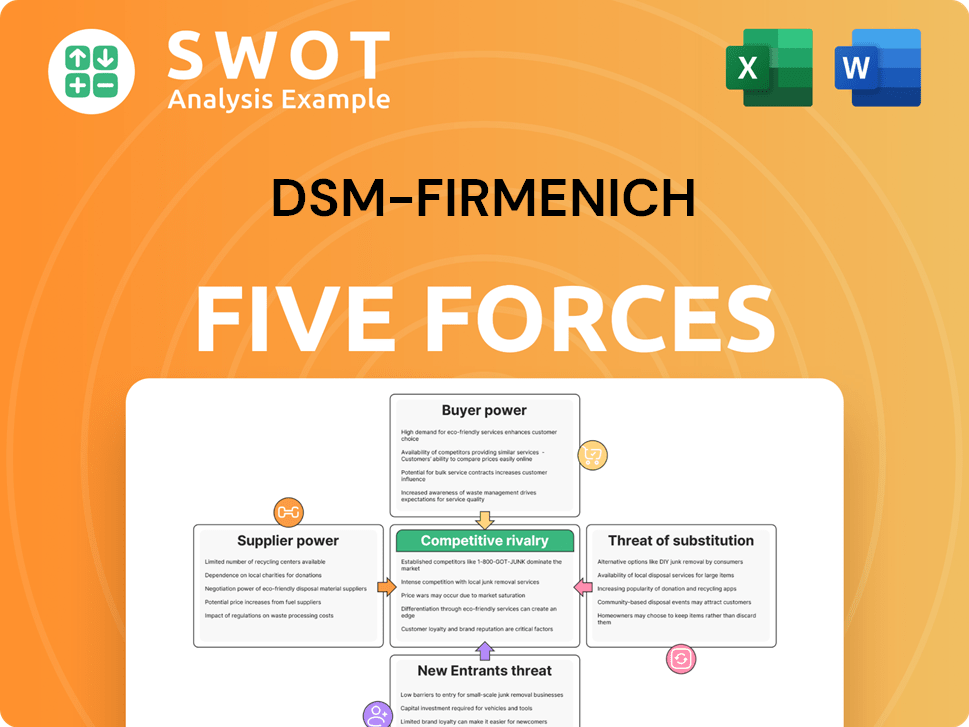
Related Blogs
- What are Mission Vision & Core Values of DSM-Firmenich Company?
- What is Competitive Landscape of DSM-Firmenich Company?
- What is Growth Strategy and Future Prospects of DSM-Firmenich Company?
- How Does DSM-Firmenich Company Work?
- What is Sales and Marketing Strategy of DSM-Firmenich Company?
- What is Brief History of DSM-Firmenich Company?
- What is Customer Demographics and Target Market of DSM-Firmenich Company?
Disclaimer
All information, articles, and product details provided on this website are for general informational and educational purposes only. We do not claim any ownership over, nor do we intend to infringe upon, any trademarks, copyrights, logos, brand names, or other intellectual property mentioned or depicted on this site. Such intellectual property remains the property of its respective owners, and any references here are made solely for identification or informational purposes, without implying any affiliation, endorsement, or partnership.
We make no representations or warranties, express or implied, regarding the accuracy, completeness, or suitability of any content or products presented. Nothing on this website should be construed as legal, tax, investment, financial, medical, or other professional advice. In addition, no part of this site—including articles or product references—constitutes a solicitation, recommendation, endorsement, advertisement, or offer to buy or sell any securities, franchises, or other financial instruments, particularly in jurisdictions where such activity would be unlawful.
All content is of a general nature and may not address the specific circumstances of any individual or entity. It is not a substitute for professional advice or services. Any actions you take based on the information provided here are strictly at your own risk. You accept full responsibility for any decisions or outcomes arising from your use of this website and agree to release us from any liability in connection with your use of, or reliance upon, the content or products found herein.